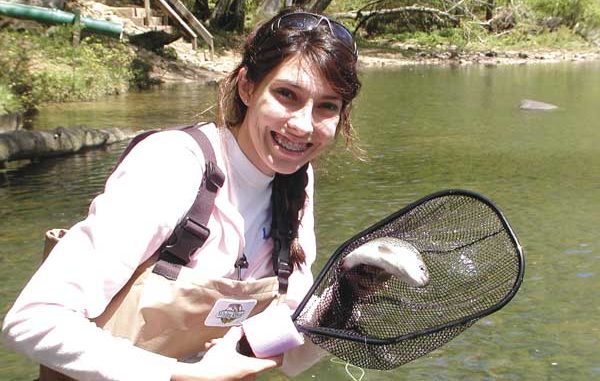
Many anglers think the month of February is the worst of the year for speckled trout fishing. That may be true in some areas, but not in Delacroix.
As Cokie brought another rainbow trout to her net, it was evident this one had been in the river for some time. “Dad, look at the colors — dark green on the back, purple on the side, slightly yellow below the jawline. This fish is still celebrating Mardi Gras.”
It may have been the Thursday after Easter, but it was indeed Mardi Gras on the Little Missouri River. The trout were telling us “throw me something,” and we were more than happy to oblige.
After Cokie released her latest catch, we took a moment to survey the situation. If there was a better day for fishing, I couldn’t imagine it. The skies were blue and calm, the vegetation was bursting with bright new leaves, insects were flying everywhere and, most important, trout were rising and smacking any bug that sat on the water.
Up to that point, she had caught and released about 20 trout. Most were pale silver fish that were recently stocked. But a few were like this last fish: rich in color and veterans of the river. When she hooked into a “vet,” line often left the reel!
Standing in calf-deep water on the edge of the river, Cokie would cast a size 16 Parachute Adams up just below cascading rocks, where the velocity of water was fastest, then allow the fly to drift back toward the slower and deeper middle. Keeping a steady eye on the fly, when the fish struck, she’d lift her rod to 45 degrees. That’s all the strike needed to set the hook — especially with a light tippet.
We continued to fish for another hour, eventually switching over to an emerger pattern created by my friend Jeff Guerin, the river’s only fulltime guide and its conservator. The “A&W Emerger” brought several more trout to the net. Many times, trout will prefer the emerging stage of a hatching mayfly, since they’re easier to nab.
Suddenly we began to hear a heightened rush to the water.
Whenever we fish a tailwater river, we look for a rock, one just breaking the surface, to use as a gauge. Glancing over to our “rock du jour,” it was evident the generators were running. We quickly made our way to high ground, then watched as the river rose and our afternoon of fishing came to an end.
My daughter has fished with me on such fabled waters as the Madison and the Norfork. How refreshing that her best day ever dry-fly fishing came this past spring on a little-known river just three hours north of Shreveport!
The Little Missouri, affectionately known as the Little Mo, begins her southward journey near Mena, Ark., in the Ouachita National Forest. She winds through rugged, steep terrain for more than 30 miles before dumping into Lake Greeson, but not before passing through the Albert Pike Recreation Area, where each winter a limited number of trout are stocked by Arkansas Fish and Game.
Although the Little Mo’s reputation as a quality trout water is based on the tailwater fishery below Narrows Dam (which forms Greeson), this upper section is worth noting. During dry seasons, the trout stay confined to the deep pools at Albert Pike, and become easy pickings for the meat haulers.
But in wet winters, the trout scatter downstream toward Lake Greeson. Much of this stretch is wilderness, accessible only by trail. The stockers quickly acclimate to the whitewater rapids. If you’re in good physical shape and not set on quantity, then here you’ll find some of the hardest-fighting fish the river has to offer.
On this day, Cokie and I had been fishing at the Hinds Bluff access some two miles below the dam. There are several other access points, beginning with a park a few hundred yards below the dam, down to “Low Water Bridge” six miles below the dam. Past the bridge, there are some trout, but unfortunately no access to the river.
Water released from the depths of Lake Greeson through its three generators is a constant 55 degrees. After completion of the dam, trout were stocked to mitigate for the decline in native warmwater species. For decades, biologists considered this a seasonal fishery, and all trout were managed for put-and-take. But Guerin saw potential.
“Although the great percentage of trout were caught out by mid-summer, there were a handful of denizens in remote areas of the river,” he said. “Come August and September, these fish had put on substantial weight, even a couple inches length, and were as bright as any wild fish you’ll find.”
Jeff rallied the support of flyrodders throughout the Ark-La-Tex region. Our support proved crucial to Arkansas Fish and Game developing a management plan that assures enough survival of trout to guarantee a productive year-round fishery. This was initially accomplished by lowering the limit to five fish per day, and creating catch-and-release-only zones on the river. Pulse generation will help keep the river temperatures down to Low Water Bridge no higher than 70 degrees in summer.
With more fish living longer, flyrodders have noticed that the trout soon acclimate to the river, its insect life and the high-velocity discharges of the generators. The result is stockers that grow fast, and quickly become as strong and wary as their wild brethren.
Reservoirs act as nutrient traps, so tailwaters are often rich with aquatic insects. The Little Mo is no exception.
“From late February through May, we have a great March Brown mayfly hatch,” Guerin said. “In late summer through October, the Light Cahills make the dry-fly fishing pretty spectacular. Those are our glamour hatches of the year. There’s always midges and caddisflies, and even some stoneflies in December through March.”
There’s something special about wading in a clear stream, hard bottom under your feet, and casting flies to rising fish. If you’ve never done it before, there’s a few things you’ll need: waders, wading boots, a vest or upper chest pack and, of course, the usuals (hat, polarized sunglasses, fly tackle, sunscreen, etc.). I strongly recommend breathable waders — they’re light for hot days but can be layered underneath for cold days. Wading boots must have felt bottoms.
A 5-weight rod is suggested, but experienced casters can enjoy the thrills of using and fighting trout on a 3-weight when using small flies.
During winter and early spring, when most of the trout are stocked and their average IQ is pretty low, olive woolybuggers are a sure thing. The tippet can be as large as 4X.
As the months roll on, and the fish get their diplomas and later their doctoral degrees, you’ll very much need to “match the hatch” and go lighter on your tippet. During early fall, Guerin has seen trout reject anything not tied to 7X.
For more information on the Little Missouri River, including fishing reports, stocking schedules, generation schedules and local accomodations, check out Jeff Guerin’s website at www.littlemissouriflyfishing.com or contact him at 870-285-2807.




